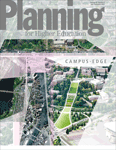- Integrated Planning
Integrated Planning
Integrated planning is a sustainable approach to planning that builds relationships, aligns the organization, and emphasizes preparedness for change.
- Topics
Topics
- Resources
Resources
Featured Formats
Popular Topics
- Events & Programs
Events & Programs
Upcoming Events
- Building Buy-in for Planning: Dealing With Resistance and Gaining Support
Online | March 11 – April 8 - Budgeting for Impact: A Working Group on Resource Planning in Higher Education
Online | Feb 5, Feb 19, March 5 - Cross-Functional Collaboration: Tools and Skills for Working Across Silos
Online | February 10, 17, 24
- Building Buy-in for Planning: Dealing With Resistance and Gaining Support
- Community
Community
The SCUP community opens a whole world of integrated planning resources, connections, and expertise.
- Integrated Planning
Integrated Planning
Integrated planning is a sustainable approach to planning that builds relationships, aligns the organization, and emphasizes preparedness for change.
- Topics
Topics
- Resources
Resources
Featured Formats
Popular Topics
- Events & Programs
Events & Programs
Upcoming Events
- Building Buy-in for Planning: Dealing With Resistance and Gaining Support
Online | March 11 – April 8 - Budgeting for Impact: A Working Group on Resource Planning in Higher Education
Online | Feb 5, Feb 19, March 5 - Cross-Functional Collaboration: Tools and Skills for Working Across Silos
Online | February 10, 17, 24
- Building Buy-in for Planning: Dealing With Resistance and Gaining Support
- Community
Community
The SCUP community opens a whole world of integrated planning resources, connections, and expertise.
 Planning for Higher Education Journal
Planning for Higher Education JournalIntegrating E-Learning to Improve Learning Outcomes
 From Volume 42 Number 4 | July–September 2014By Anne Davies
From Volume 42 Number 4 | July–September 2014By Anne DaviesLearning happens best when students are engaged with the topic and productive participation is at its highest. The challenge in education is how to reach students at each level of development to increase motivation and intention. Instruction must be culturally responsive to support the achievement of a diverse population using a framework that meets the appropriate level of learning for each student in the affective, cognitive, and psychomotor domains in order to inspire creativity and innovation. In teaching in the medical field, the faculty is faced with the same challenges, since the theories taught in medical education are difficult for students to grasp. There are fewer designated methods for medical education than for general education, leading many educators to fall back on standard lectures. However, traditional lecture materials and class-time methods fail to meet the learning needs of all students. A proven way for teachers to engage students and improve learning outcomes is through the relevant use of e-learning and Web 2.0 tools in teaching. The literature supports the case for integrating e-learning and Web 2.0 technologies into medical education to improve learning outcomes.
MEMBERS ONLY
Attention Members: Log in to access this item.Not a member? Join now to access this article and all journal articles for free. - Topics
- Topics


